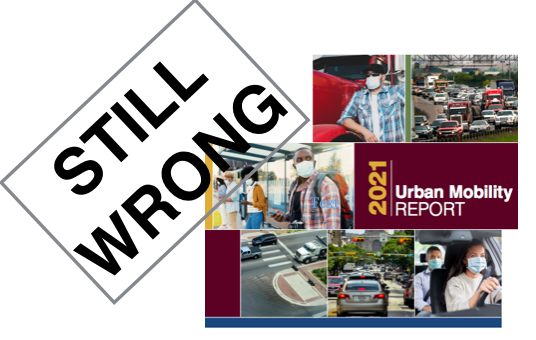By Joe Cortright, City Observatory
There was an unprecedented decline in traffic congestion in the US last year. According to the Urban Mobility Report, there’s essentially nothing we can learn from this experience
The Texas Transportation Institute has always been apologists and propagandists for the highway lobby
TTI reports fail the basic scientific test of responding to repeated detailed critiques of methodology, measures and findings
Every year (or so), the Texas Transportation Institute generates something called the “Urban Mobility Report,” which is a dire lamentation on the supposed costs that urban traffic congestion imposes on Americans.
This past week, they’ve issued their latest report, covering 2020. As everyone knows, the Covid-19 pandemic produced an instant and abrupt change in US travel patterns. And that’s noted in the latest UMR. Their measure of congestion—which, as we’ll explain in a minute, is deeply flawed and biased—actually showed a epic decline in congestion costs in 2020. So far, so good. But wait.
Now, for scientists and the intellectually curious, you would think that actually experiencing a dramatic decline in traffic congestion would be, if not a cause for celebration, at least an opportunity to better understand the dynamics of the problem they’re purportedly concerned with solving.
Here’s the big, salient fact about traffic in 2020: Travel declined by about 15-20 percent, but congestion—as measured by TTI—fell by about half. Here’s the data on quarterly travel volumes in 2020 compared to the previous year. In the second half of the year, travel was down about 15-20 percent.
While travel went down a bit, traffic congestion went down a lot. Even in the second half of the year, as travel had rebounded, traffic congestion, measured here by TTI’s own estimate of hours of delay, was down 40 to 50 percent from 2019 levels.
As we’ve stressed at City Observatory, this non-linearity (a small decline in travel produces a big decline in congestion) is the most important insight we can have about how to deal with traffic. In Portland, during the height of the pandemic-fueled travel reductions, the city’s major freeways carried more cars at the rush hour, at higher speeds, because traffic levels were kept below the tipping point that causes cascading delays.
Traffic congestion is a demand problem: too much demand at certain times, specifically peak hours. If we can reduce demand, or shift travel to off-peak times, we can dramatically reduce congestion. We have traffic congestion because we don’t price roads; we don’t systematically reflect back to users the costs their travel decisions impose on others.
The only effective solutions to traffic congestion involve congestion pricing, but “pricing” is one word you won’t find anywhere in the 2021 Urban Mobility Report. The word “toll” appears exactly once.
TTI has never grasped the fundamental economics of traffic congestion. They’ve always pretended that the transportation system can be run as if every day was free ice cream day at Ben and Jerry’s. If you don’t charge users for your product, you get lines around the block and you’re always running short of money.
The real lesson of the pandemic, if we recognize it, is that measures to alter travel demand, especially ones that incorporate real time pricing, can re-shape demand in ways that reduce congestion. In fact, evidence from the pandemic shows that avoiding over-loading roads at peak hours can maintain consistent high travel speeds and higher levels of vehicle throughout.
However, if you read the TTI report, you’ll never learn any of that. Instead, what you’ll hear is that when the pandemic abates, the world of transportation will trend back toward increased traffic and congestion, and well, we’ll just have to build more capacity to accommodate it.
Add capacity in critical corridors — We just need “more” in some places. Increases in freight and person movement often require new or expanded facilities. Important corridors or growing regions can benefit from more street and highway lanes, new or expanded public transportation facilities, and larger bus and rail fleets.
That’s TTI doing what it has always done: providing a rationalization for ever more highways in the name of trying—counterproductively, as it turns out—to reduce congestion.
Flawed, biased and unscientific
Though it has been produced for decades, the Texas Transportation Institute’s Urban Mobility Report is essentially propaganda for road-building, not a critical analysis of transportation policy. It is designed to generate heat, not shed light. We and others have repeatedly refuted and debunked the methodology, metrics, and findings in this and prior TTI reports. Some of the highlights:
- Its core measure of delay, the “travel time index” ignores the distance of trips across metro areas, and incorrectly penalizes cities with compact development and shorter trips, while rewarding sprawling metros with very long commutes.
- Claims that congestion imposes net costs on travelers is based on the false assumption that enough highway capacity could be constructed so that peak hour travel was never slower than off-peak hour travel.
- The first three decades of the report’s congestion estimates are based on a flawed and unscientific extrapolation of speed-volume tables, and are inconsistent with other measures of actual travel time. The report presents as a single time series estimates made using wildly varying methodologies.
- As Victoria Transportation Policy Institute’s Todd Litman has shown, the report’s authors have repeatedly failed to respond to thorough and well-researched critiques of their methodology.
Our experiences with a very changed transportation system during the Covid-19 pandemic could have been (and could still be) a powerful learning moment as to how to build more just, sustainable and efficient cities. We observed that reducing transportation demand can greatly improve the function of the transportation system, reducing congestion and travel times, and improving air quality. Greater emphasis on walking, biking, and repurposing public space for people instead of car movement and car storage can make our cities better places to live, rather than merely easier to drive through. Alas, these are lessons that will never be learned by anyone who places any credence in the Urban Mobility Report.
About City Observatory
City Observatory is a website and think tank devoted to data-driven analysis of cities and the policies that shape them.
The website will feature posts that tackle misconceptions about cities, break down the latest urban research, and highlight the innovative ideas that strengthen our communities.
The site will cover topics such as transportation, housing, gentrification, place making, economic opportunity, and industry clusters. Core topics will be addressed in issue “cards” that will be updated on a consistent basis to reflect the latest data and research.
Periodically, the site will feature in-depth research report and papers on urban policy topics like crime in cities, traffic congestion, neighborhood change, and migration. City Observatory is based in Portland, Oregon—a city synonymous with creative urban thinking—but our vision is nationwide in scope, looking at the best ideas for promoting city success, wherever they originate.






